Buick Vehicle Line Executive: No Wiring Problems With Production Buick LaCrosse
TTAC recently published a Wild Ass Rumor about Buick LaCrosse wiring problems. Jim Federico breached the GM – TTAC wall to quash the suggestion that production vehicles suffered from electrical gremlins. “I can confirm there is NO truth to this RUMOR,” the LaCrosse Vehicle Line Executive/Chief Engineer wrote. So I called the man responsible for “any car on the GM Global Mid-Size platform until I retire or get fired, whatever comes first.” [Note: GM no longer uses Greek names for its platforms. Literally. Federico flat-out refused to identify the Buick’s platform as an “Epsilon.”] Federico told me GM has delivered roughly a thousand LaCrosse to dealers; only one has been marked return to sender. “It was a car with a burned-out starter,” he revealed. “We identified the problem as a defective component and contacted the supplier to rectify the situation.” Now, as for that wiring rumor . . .
The LaCrosse is the first North American vehicle where assembly workers burn/download the software into the BCM (Body Control Module) and ECM (Engine Control Module) on the factory floor. As such, there were some electrical issues with the LaCrosse PPVs (Pre-Production Vehicles). “It’s nothing more than we expected in the normal development process,” Federico claimed. “About 70 percent good, 30 percent bad.” He said these problems were resolved before customer cars came off the line.
Federico was anxious for me to sample his handiwork firsthand. His GM PR handler (listening in as always) promised to arrange a press car for a TTAC review.
As Federico is in charge of all the American automaker’s Voldemorts—I mean, future Global Mid-Size Platform vehicles, I asked him if he saw any problems sharing the platform across GM’s four remaining brands. Federico rattled off a laundry list (so to speak) of all the ways the Epsilons would differ: fuel economy, handling dynamics, sheet metal, interior, etc. “We are not badge engineering,” he insisted.
We shall see.
More by Robert Farago
Latest Car Reviews
Read moreLatest Product Reviews
Read moreRecent Comments
- Mike Bradley Autonomous cars were developed in Silicon Valley. For new products there, the standard business plan is to put a barely-functioning product on the market right away and wait for the early-adopter customers to find the flaws. That's exactly what's happened. Detroit's plan is pretty much the opposite, but Detroit isn't developing this product. That's why dealers, for instance, haven't been trained in the cars.
- Dartman https://apnews.com/article/artificial-intelligence-fighter-jets-air-force-6a1100c96a73ca9b7f41cbd6a2753fdaAutonomous/Ai is here now. The question is implementation and acceptance.
- FreedMike If Dodge were smart - and I don't think they are - they'd spend their money refreshing and reworking the Durango (which I think is entering model year 3,221), versus going down the same "stuff 'em full of motor and give 'em cool new paint options" path. That's the approach they used with the Charger and Challenger, and both those models are dead. The Durango is still a strong product in a strong market; why not keep it fresher?
- Bill Wade I was driving a new Subaru a few weeks ago on I-10 near Tucson and it suddenly decided to slam on the brakes from a tumbleweed blowing across the highway. I just about had a heart attack while it nearly threw my mom through the windshield and dumped our grocery bags all over the place. It seems like a bad idea to me, the tech isn't ready.
- FreedMike I don't get the business case for these plug-in hybrid Jeep off roaders. They're a LOT more expensive (almost fourteen grand for the four-door Wrangler) and still get lousy MPG. They're certainly quick, but the last thing the Wrangler - one of the most obtuse-handling vehicles you can buy - needs is MOOOAAAARRRR POWER. In my neck of the woods, where off-road vehicles are big, the only 4Xe models I see of the wrangler wear fleet (rental) plates. What's the point? Wrangler sales have taken a massive plunge the last few years - why doesn't Jeep focus on affordability and value versus tech that only a very small part of its' buyer base would appreciate?


































Comments
Join the conversation
Mark MacInnis So when you build a preproduction run of highly complex electro-mechanical devices your quality is extremely high? Why do you build preproduction then? Please share your personal hands on experiences with us. (or at least guys like our beloved RF) Oh, and why don't you guys get a room?